1993 BUICK RIVIERA engine oil
[x] Cancel search: engine oilPage 14 of 324
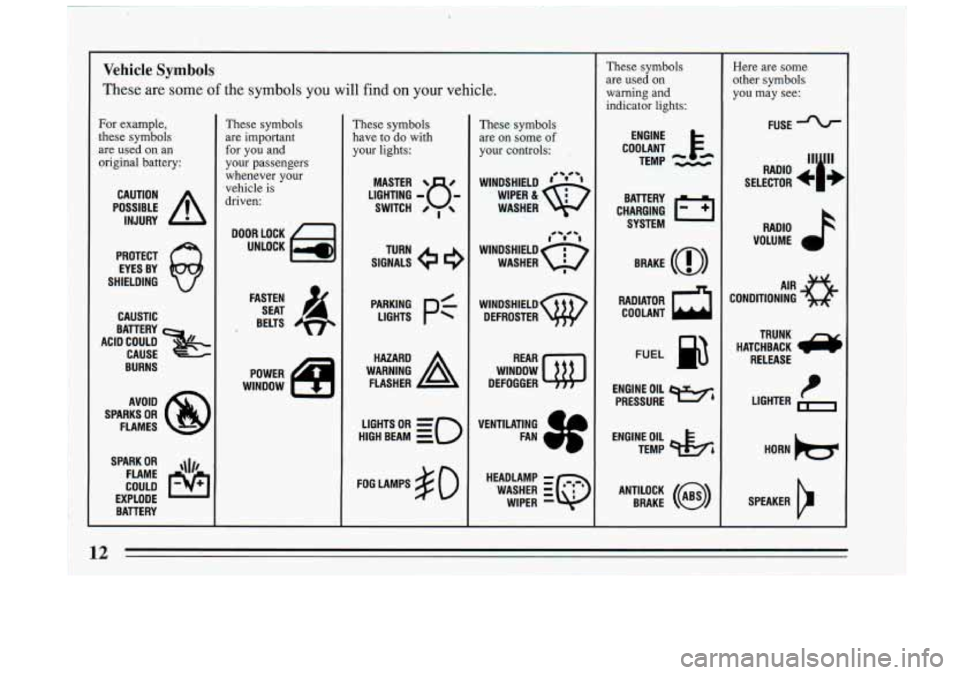
Vehicle Symbols
These are some of the symbols you will find on your vehicle.
For example,
these symbols
are used on an
original battery:
POSSIBLE A
CAUTION
INJURY
PROTECT EYES BY
SHIELDING
CAUSTIC
BURNS AVOID
SPARKS
OR
FLAMES
SPARK
OR ,111,
COULD pq
FLAME
EXPLODE BATTERY
These symbols
are important
for you and
your passengers whenever your
vehicle
is
driven:
FASTEN SEAT 4
BELTS
These symbols
have to do with
your lights:
SIGNALS TURN
HIGH BEAM
OR = =o
FOG LAMPS $0
These symbols
are on some
of
your controls:
WINDSHIELD ’ ’ ’ 4- #-
WASHER
f0 -**
WINDSHIELD Q
WASHER I
WINDSHIELD
DEFROSTER
WINDOW
DEFOGGER
VENTILATING
FAN
L.
HEADLAMP - ,~*-,
WASHER iQ
WIPER -
L
These symbols
are used on
warning and
indicator lights:
COOLANT F-
TEMP --
ENGINE
CHARGING
I-1
BATTERY SYSTEM
RADIATOR
a
COOLANT
FUEL
ENGINE OIL
PRESSURE
Wb
TEMP OIL &
ANTILOCK (@)
BRAKE
Here are some
other symbols
you may see:
FUSE
RADIO
‘‘ill
SELECTOR
RADIO
k
VOLUME
CONDITIONING
AIR 33
HATCHBACK /y
TRUNK
RELEASE
t LIGHTER 1-
HORN
SPEAKER
cr
~ 12 , .
Page 76 of 324
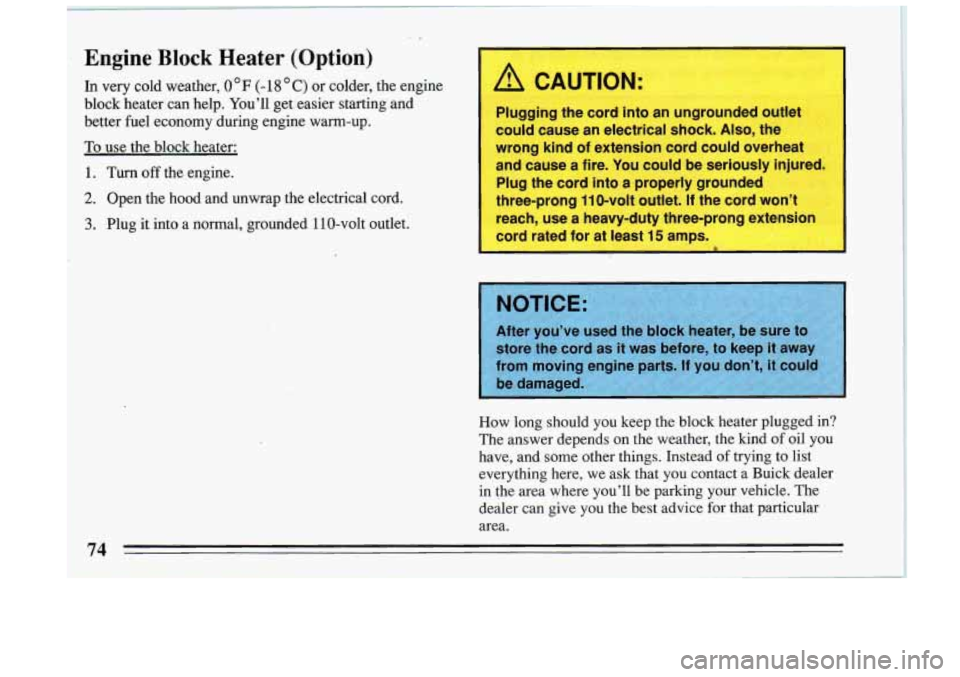
Engine Block Heater (Option)
In very cold weather, 0 F (- 18 C) or colder, the engine
block heater can help. You’ll get easier starting and
better fuel economy during engine warm-up.
j To use the block heater: I
I. Turn off the engine.
L. Open the hood and unwrap the electrical cord.
1 3. Plug it into a normal, grounded 110-volt outlet.
A CAUTION:
Plugging the cord into an ungrounded outlet
could cause an electrical shock.
Also, the
wrong kind of extension cord could overheat
and cause
a fire. You could be seriously injured.
Plug the cord into
a properly grounded
three-prong 110-volt outlet.
If the cord won’t
reach, use
a heavy-duty three-prong extension
cord rated for at least
15 amps.
How long should you keep the block heater-plugged in?
The answer depends on the weather, the kind
of oil you
have, and some other things. Instead
of trying to list
everything here, we ask that you contact
a Buick dealer
in the area where you’ll be parking your vehicle. The
dealer
can give you the best advice for that particular
area.
74
Page 110 of 324

Fuel Gage
I
Your fuel gage is a bar graph. When you fill the tank,
the bar segments will light up. The fuel gage shows
about how much fuel is in your
tank. It works only when
the ignition is on. When the fuel gage shows only two
bar segments the
“LOW’ light will come on. If the fuel
~ supply is in the one bar segment, the yellow warning bar
’ will flash to remind you to get more fuel soon.
At the gas station, the gas pump shuts off before the
gage reads
“F’.
It takes more (or less) gas to fill up than the gage
said. For example, the gage said
1/2 full, but it took
more
- or less - than half of the tank’s, capacity to fill
it.
Engine Oil Pressure Gage and Light
When “LOW, comes on
there could be a problem
with your engine oil
pressure.
~ Here are concerns some owners have had about the fuel You
can also read your oil pressure directly from the
~ gage. All these situations are normal and indicate gage on you\
r instrument panel.
I
nothing wrong with the fuel gage.
j 108 I ~ 1 1
Page 111 of 324
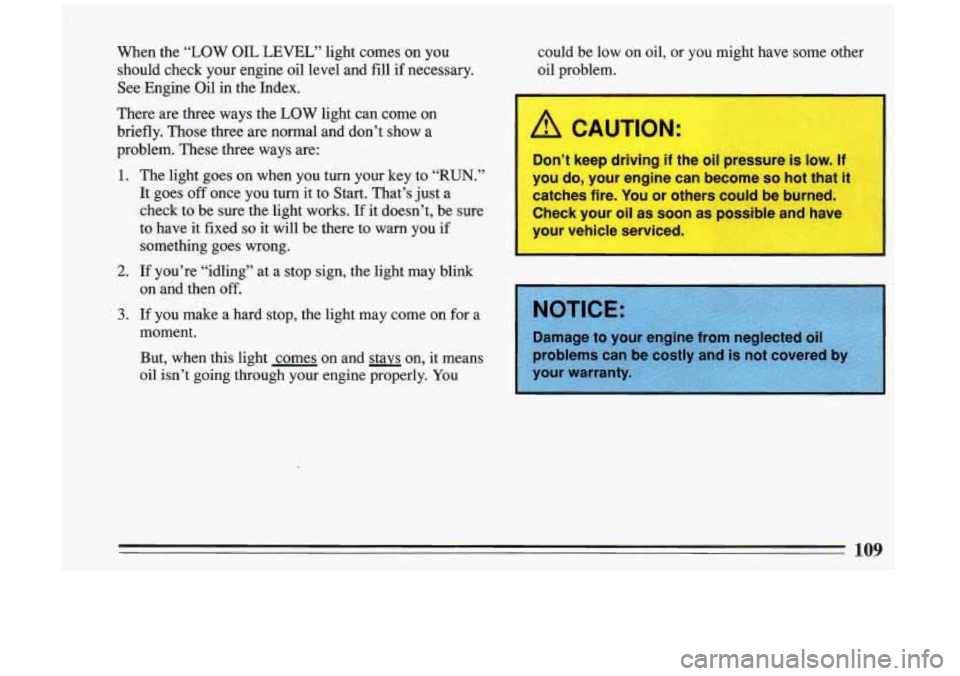
When the “LOW OIL LEVEL” light comes on you
should check your engine oil level and
fill if necessary.
See Engine Oil in the Index.
There are three ways the
LOW light can come on
briefly. Those
three are normal and don’t show a
problem. These three ways are:
1.
2.
3.
could be low on oil, or you might have some other
oil problem.
CAUTION:
Don’t keep driving if the oil pressure is low. If
109
Page 174 of 324
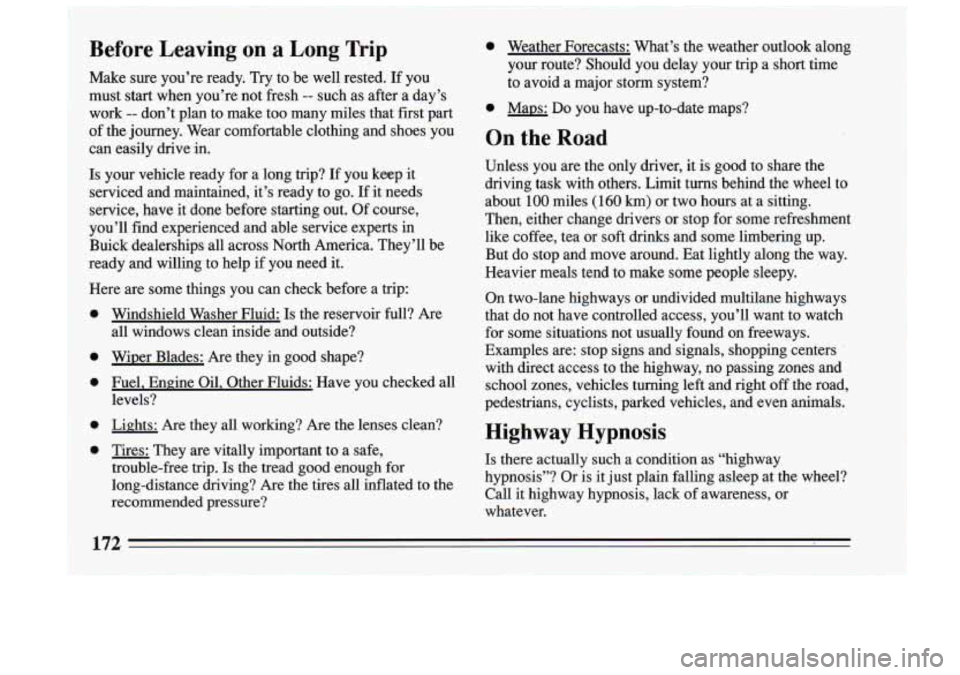
~ Before Leaving on a
Long Trip 0 Weather Forecasts: What’s the weather outlook along
your route? Should
you delay your trip a short time
Make sure you’re ready. Try to be well rested. If you to avoid a major storm system?
must start when you’re not fresh
-- such as after a day’s
work
-- don’t plan to make too many miles that first part 0 Maps: Do you have up-to-date maps?
I
of the journey. Wear comfortable clothing and shoes you
can easily drive in. On the Road
Is your vehicle ready for a long trip? If you keep it
serviced and maintained, it’s ready to go. If it needs
service, have it done before starting out. Of course,
you’ll find experienced and able service experts in
Buick dealerships all across North America. They’ll be
ready and willing to help if
you need it.
Here are
some things you can check before a trip:
0 Windshield Washer Fluid: Is the reservoir full? Are
all windows clean inside and outside?
0 Wiper Blades: Are they in good shape!
0 Fuel, Engine Oil, Other Fluids: Have you checked all
levels?
0 Lights: Are they all working? Are the lenses clean?
0 Tires: They are vitally important to a safe,
trouble-free trip.
Is the tread good enough for
long-distance driving?
Are the tires all inflated to the
recommended pressure? Unless you
are the only driver, it is good to share
the
driving task with others. Limit turns behind the wheel to
about
100 miles (160 km) or two hours at a sitting.
Then, either change drivers or stop for some refreshment
like coffee, tea or soft drinks and some limbering up. But do stop and move around. Eat lightly along the way.
Heavier meals tend to make some people sleepy.
On two-lane highways or undivided multilane highways
that do not have controlled access, you’ll want to watch for some situations not usually found on freeways.
Examples are: stop signs and signals, shopping centers with direct access to the highway, no passing zones and school zones, vehicles turning left and right off the road,
pedestrians, cyclists, parked vehicles. td even animals.
Highway Hypnosis
Is there actually such a condition as “highway
hypnosis”?
Or is it just plain falling asleep at the wheel?
Call
it highway hypnosis, lack of awareness, or
whatever.
172
Page 200 of 324
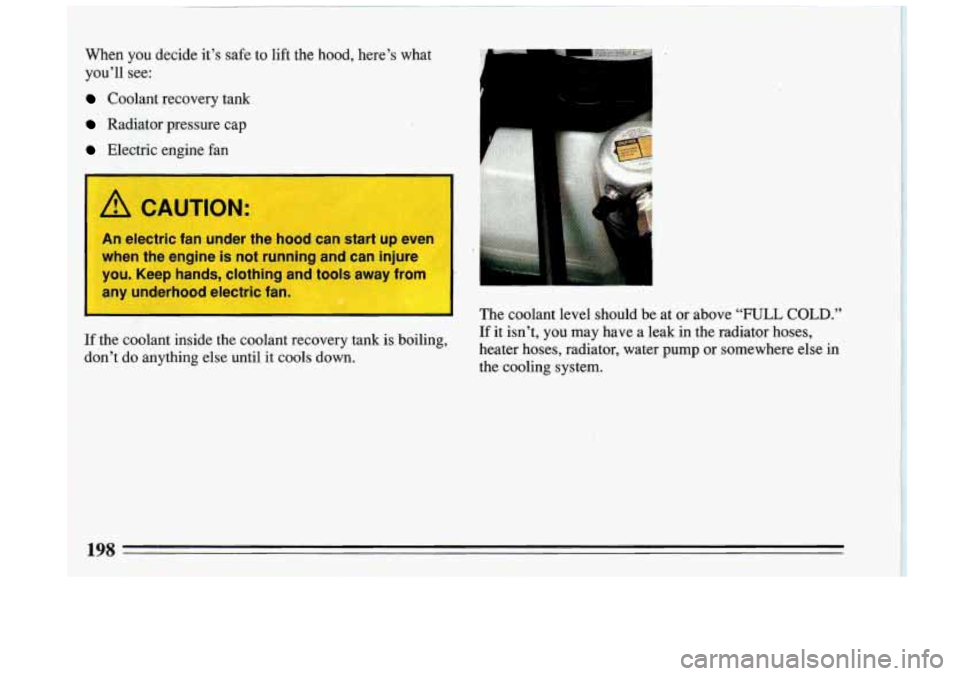
When you decide it’s safe to lift the hood, here’s what
you’ll
see:
Coolant recovery tank
Radiator pressure cap
Electric engine fan
An electric fan under the hood can start up even
when the engine is not running and can injure
you. Keep hands, clothing and tools away from
any underhood electric fan.
I
If the coolant inside the coolant recovery tank is boiling,
don’t do anything else until it coals down. The coolant level should be at or above
“FULL COLD.”
If it isn’t, you may have a leak in the radiator hoses,
heater hoses, radiator, water pump or somewhere else
in
the cooling system.
198
Page 201 of 324

I
A CAUTION:
' ~ Heater and radiator hoses, and other engine
--# parts, can be very hot. Don't touch them. If you I 1
.': do, you can be burned.
Don't
run the engine if there is a leak. If you run
the engine,
it could lose all coolant. That could
..~ cause an engine fire, and you could be burned.
I_ '1 Get any leak fixed before you drive the vehicle. /I
,
A CAUTION:
Adding only plain water to your cooling system
can be dangerous. Plain water, or some other
liquid like alcohol, can boil before the proper
coolant mix
will. Your vehicle's coolant warning
system
is set for the proper coolant mix. With
plain water or the wrong mix, your engine could
get too hot but you wouldn't get the overheat
warning. Your engine could catch fire and you
or others could be burned. Use a
5060 mix of
clean water and a proper antifreeze.
Page 220 of 324
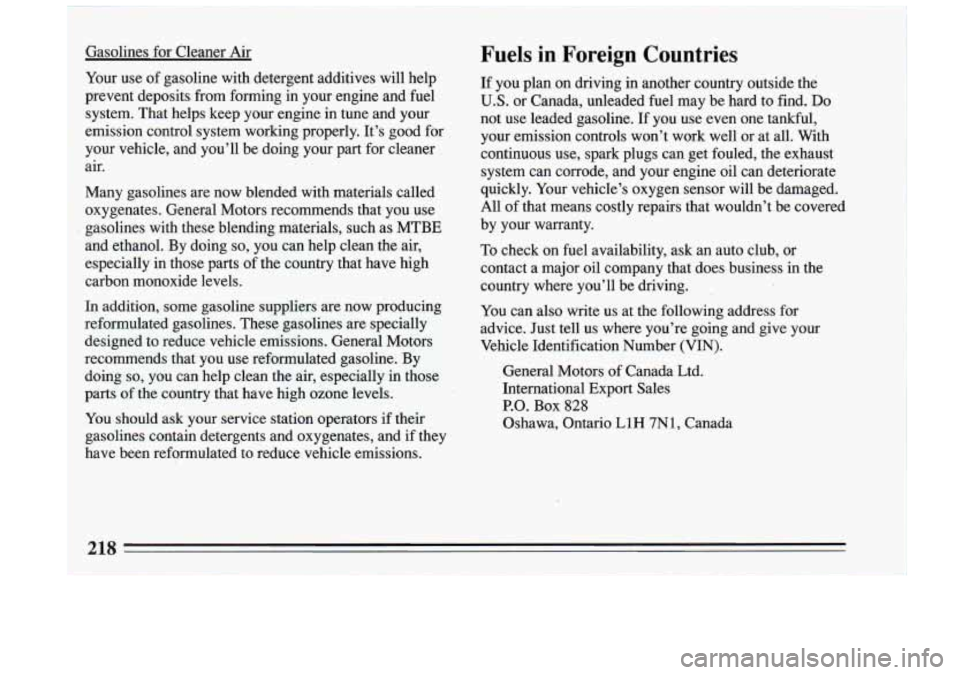
I
Gasolines for Cleaner Air
Your use of gasoline with detergent additives will help
prevent deposits from forming in your engine and fuel
system. That helps keep your engine in tune and your
emission control system working properly. It’s good €or
your vehicle, and you’ll be doing your part for cleaner
air.
Many gasolines are now blended with materials called oxygenates. General Motors recommends that you use
gasolines with these blending materials, such as MTBE
and ethanol. By doing
so, you can help clean the air,
especially in those parts
of the country that have high
carbon monoxide levels.
In addition, some gasoline suppliers are now producing
reformulated gasolines. These gasolines are specially
designed to reduce vehicle emissions. General Motors
recommends that you use reformulated gasoline. By
doing
so, you can help clean the air, especially in those
parts of the country that have high Ozone levels.
You should ask your service station operators if their
gasolines contain detergents and oxygenates, and if they
have been reformulated
to reduce vehicle emissions.
Fuels in Foreign Countries
If you plan on driving in another country outside the
U.S. or Canada, unleaded fuel may be hard to find. Do
not use leaded gasoline. If you use even one tankful,
your emission controls won’t work well or at all. With
continuous use, spark plugs can get fouled, the exhaust system can corrode, and your engine oil can deteriorate
quickly. Your vehicle’s oxygen sensor will be damaged.
All of that means costly repairs that wouldn’t be covered
by your warranty.
To check on fuel availability, ask an auto club, or
contact a major oil company that does business in the
country where you’ll be driving.
You can also write us at the following address for
advice. Just tell us where you’re going and give your
Vehicle Identification Number
(VIN).
General Motors of Canada Ltd.
International Export Sales
P.O. Box 828
Oshawa, Ontario L1H 7N1, Canada
218